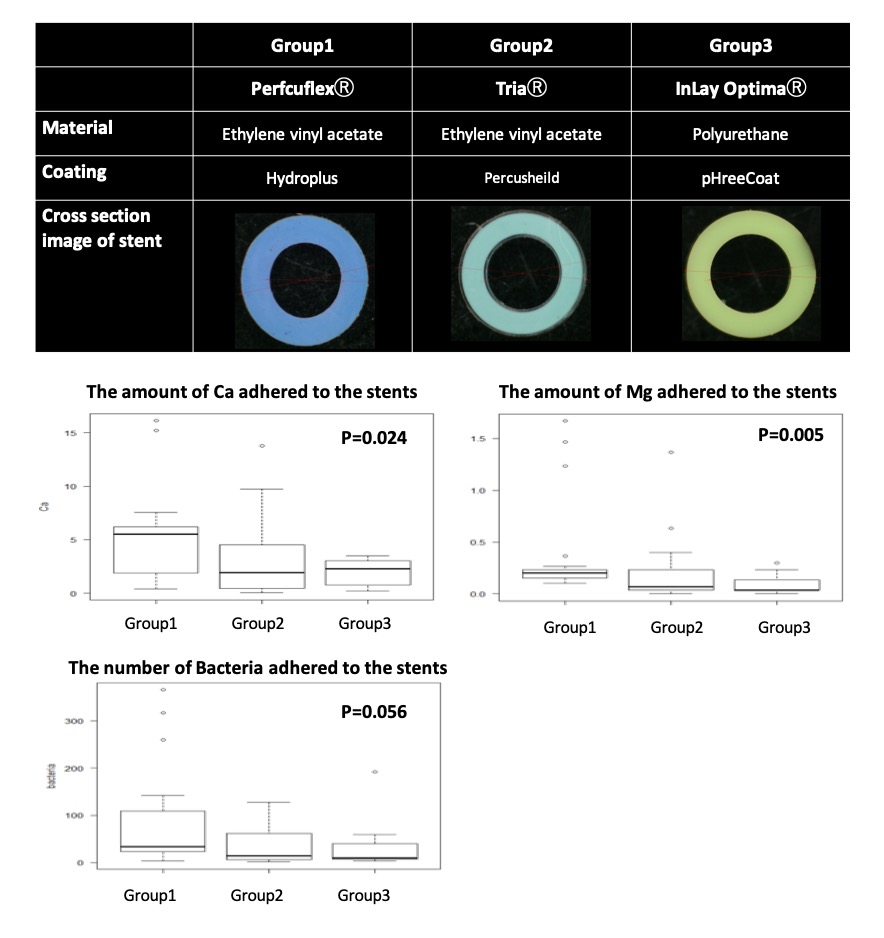Back
Poster, Podium & Video Sessions
Moderated Poster
MP44: Stone Disease: Surgical Therapy (including ESWL) III
MP44-09: A prospective, randomized, single-blind study of ureteral stent biomaterial encrustation after ureteroscopic lithotropisy
Sunday, May 15, 2022
1:00 PM – 2:15 PM
Location: Room 228
Shuzo Hamamoto*, Ryosuke Chaya, Kazumi Taguchi, Kengo Kawase, Tomoki Okada, Tatsuya Hattori, Terukaki Sugino, Rei Unnno, Atsushi Okada, Takahiro Yasui, Nagoya, Japan

Shuzo Hamamoto, MD
Assistant Professor
Nagoya city University graduate school of Medical Sciences
Poster Presenter(s)
Introduction: Ureteral stents are commonly used in endoscopic surgery for urinary calculi but are frequently associated with stent encrustation and stent-related infections. New biomaterials and coatings have been designed to overcome these disadvantages. However, there are no real-world reports comparing biomaterial encrustation of different stents. In this study, we prospectively evaluated the adherence of bacteria, Ca, and Mg to three different ureteral stents after endoscopic surgery for urinary calculi.
Methods: A total of 61 patients requiring insertion of ureteral stents after the treatment of urinary calculi were randomly placed into 3 groups [Percuflex? with a coating composition of Hydroplus, Group 1 (n=21); Tria, with a coating composition of Percushied?, Group 2 (n=22); InLay Optima?, which had a proprietary pHreeCoat coating, Group 3 (n=18)]. All stents were removed one month after treatment and evaluated. A stent was immersed in a solution of saline and hydrochloric acid at pH 2 and subsequently vortexed for one hour. Ca and Mg contents were measured using atomic absorption spectrometry. Bacteria were measured using flow cytometry.
Results: There were no significant differences about patients and stone characteristics. The incidence of stone encrustation was significantly higher in Group 1 than in Groups 2 and 3 (33.3%, 11.7%, and 7.7%, respectively; p=0.02). The median amount (IQR) of Ca adhered to the stents in Group 1 was significantly higher than that in Groups 2 and 3 (5.51 (2.28-6.18), 1,91 (0.53-4.48), 2.30 (0.76-3.03) mg/dL respectively, p=0.024). The median amount (IQR) of Mg in Group 1 was significantly higher than that in Groups 2 and 3 (0.20 (0.15-0.23), 0.06 (0.04-0.20), 0.03 (0.03-0.13) mg/dL respectively, p=0.005). The median number (IQR) of bacteria was also highest in Group 1 (33.76 (23.13-109.43), 13.80 (6.23-56.25), 8.33 (6.80-21.20), respectively, p=0.056); however, there were no significant differences in bacterial adhesion.
Conclusions: This randomized study showed that stents with Percusheild coating and pHreeCoat coating decreased the adherence of Ca, Mg after endoscopic treatment. These stents could reduce stent encrustation and stent-related infections.
Source of Funding: none

Methods: A total of 61 patients requiring insertion of ureteral stents after the treatment of urinary calculi were randomly placed into 3 groups [Percuflex? with a coating composition of Hydroplus, Group 1 (n=21); Tria, with a coating composition of Percushied?, Group 2 (n=22); InLay Optima?, which had a proprietary pHreeCoat coating, Group 3 (n=18)]. All stents were removed one month after treatment and evaluated. A stent was immersed in a solution of saline and hydrochloric acid at pH 2 and subsequently vortexed for one hour. Ca and Mg contents were measured using atomic absorption spectrometry. Bacteria were measured using flow cytometry.
Results: There were no significant differences about patients and stone characteristics. The incidence of stone encrustation was significantly higher in Group 1 than in Groups 2 and 3 (33.3%, 11.7%, and 7.7%, respectively; p=0.02). The median amount (IQR) of Ca adhered to the stents in Group 1 was significantly higher than that in Groups 2 and 3 (5.51 (2.28-6.18), 1,91 (0.53-4.48), 2.30 (0.76-3.03) mg/dL respectively, p=0.024). The median amount (IQR) of Mg in Group 1 was significantly higher than that in Groups 2 and 3 (0.20 (0.15-0.23), 0.06 (0.04-0.20), 0.03 (0.03-0.13) mg/dL respectively, p=0.005). The median number (IQR) of bacteria was also highest in Group 1 (33.76 (23.13-109.43), 13.80 (6.23-56.25), 8.33 (6.80-21.20), respectively, p=0.056); however, there were no significant differences in bacterial adhesion.
Conclusions: This randomized study showed that stents with Percusheild coating and pHreeCoat coating decreased the adherence of Ca, Mg after endoscopic treatment. These stents could reduce stent encrustation and stent-related infections.
Source of Funding: none


.jpg)
.jpg)